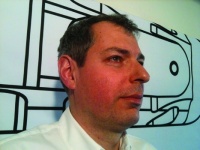
Mark Chapman Biography
Chief Engineer
Bloodhound SSC Project
Education
1992 BEng in Aeronautical Engineering, Bath University
Career
Varied work with Babcock, including submarine weapons systems and CFD on sewage-works components
Principal engineer for Ricardo Aerospace, including forward section of air taxi with Richard Noble; initial design on Joint Strike Fighter
Boeing Propulsion Systems, Seattle
Rolls-Royce, working on JSF STOVL take-off system
2008 Joins Bloodhound SSC project full-time
2010 Takes on chief-engineer position at Bloodhound
Q&A Resolving problems facing the Bloodhound SSC
What engineering issues have you recently faced?
For the past six months my head has barely risen above my CAD station. In the initial stages of development, we worked with a configuration that had the rocket engine above the jet engine and we’d got to the point where we knew how to work that car, aerodynamically. The rocket had steadily been getting bigger and we were working to get the weight down, but then we started looking at the forces we’d need on the control surfaces. We found that in the situations where you were turning the rocket on and off, the control surfaces had to work really hard, and that gave us a problem with failure cases.
Was that connected with the engine positions?
When the rocket engine was on, it generated a downward force towards the front of the car, so to counteract that, the front control surfaces had to generate a small amount of lift. But in a case where the front hydraulics failed, the first thing you’d want to do would be to turn the rocket off, to slow the car down. That would remove the downforce and the risk was that the lift from the front surfaces would flip the car up. It was difficult to imagine a way the system could fail safely.
Why does changing from rocket-over-jet to jet-over-rocket help with this?
With the jet-over-rocket configuration, the engines are actually positioned on either side of the centre of thrust, which is a much more stable configuration. The car was more stable and easier to control. But we had understood the aerodynamics of the rocket-over-engine configuration – we had stabilised it transonically and supersonically. When we flipped the positions, a lot of the aerodynamics that we thought would work suddenly wouldn’t. The shape of the rear of the car had to be quite different.
How have you managed the redesign?
We’re relying heavily on our simulation systems and Matlab to analyse the data and find what works. In the 18 months we were working with rocket-over-jet, we did maybe 12 or 13 CFD runs. In three months where we were working on jet-over-rocket, we did 120 runs and that gave us an equation for a car that works. It’s given us a shape we wouldn’t have predicted; team aerodynamicist Ron Ayers took a look and said he’d never have picked that shape. It’s been so successful we are looking at rolling out this analysis technique to other parts of the car design.


Nanogenerator consumes CO2 to generate electricity
Nice to see my my views being backed up by no less a figure than Sabine Hossenfelder https://youtu.be/QoJzs4fA4fo